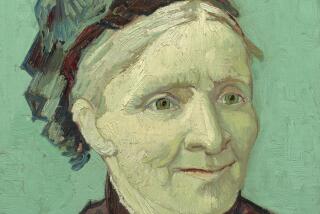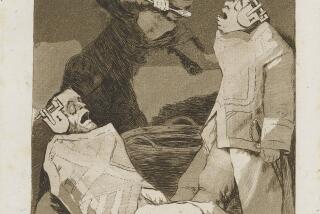It’s All About $$$$$ : The battle for pop star Andy Warhol’s fortune : DEATH AND DISASTER: The Rise of the Warhol Empire and the Race for Andy’s Millions, <i> By Paul Alexander (Villard Books: $23; 256 pp.)</i>
- Share via
Between the pop star and the lone assassin there is more than a family resemblance. A kind of glistening senselessness characterizes their lives, as if the personal histories of these quintessential American types have been emptied of content to make room for the fantasies of millions. But something cannot be built out of nothing.
There must be a predisposition to stardom, just as there is a talent for high crimes and misdemeanors, rooted in the humble origins of gargantuan conceits. Such is certainly the case of pop star Andy Warhol, ne Warhola, “a sphinx with no secrets,” Truman Capote called him, who rose from the sooty streets of Pittsburgh in the late 1920s and ‘30s to become, with his famous pointy-toed shoe illustrations for I. Miller, and his ad campaigns for Bonwit Teller and Lord & Taylor in the 1950s, “the Leonardo da Vinci of Madison Avenue.”
When Warhol made his raid on fine art in 1960-62, with his paintings of Coke bottles and Campbell Soup cans, television sets and water heaters, the art world was ready for him. Brand-name “action” painting color-keyed to executive suites had become as common as Andy Warhol’s spangled images of Marilyn Monroe would become in later decades.
In the early ‘60s, however, especially after 1962, when Warhol discovered silk-screening and the images multiplied (“Numbers sanctify,” intones Charlie Chaplin in “Monsieur Verdoux,” an observation Warhol might have made), the tinsel-haired waif from Carnegie Tech took New York by storm. During this period, Adam Gopnik later wrote in the New Yorker: “Andy Warhol, then a Madison Avenue fashion illustrator with a small specialty in ladies’ shoes, made paintings of fading movie stars, dollar bills, and cans of condensed soup, and afterward became for a while the most influential modern artist in the world.”
Warhol’s most lasting influence, however, is the one for which he is still reviled: This was his penchant for turning fine art into a branch of show business; for loosening, perhaps irrevocably, the tie between art and seriousness.
Warhol the showman, in fact, who lampooned celebrity while cultivating it, is a more interesting figure than the fabricator of mass images. Who knows but that someday he will take his place beside the great trickster-artists of the American past: P.T. Barnum, “Buffalo Bill” Cody, Frank Baum, and (for Warholisms like “Death means a lot of money, honey”) W. C. Fields.
That Warhol the craftsman, meanwhile, was quite capable of working directly for the market must be weighed against the fact that he worked for a market he created. He made what the painter Jack Tworkov once called “commercial fine art”: “an object of high fashion that will look like pioneering art, only it will look more sleek.”
There is barely a whiff of this polychrome character in Paul Alexander’s book, which is not about Warhol’s showmanship and only marginally about his art but about what came later. After a fatal heart attack on Feb. 22, 1987, in New York Hospital following routine gallbladder surgery, Warhol’s empire emerged in a few short years as the centerpiece of a fierce legal contest, still under way. Battling each other for Warhol’s millions are his long-time business manager and executor, Frederick W. Hughes, the attorney Hughes hired to help settle the estate and establish the foundation called for in Warhol’s will, Edward W. Hayes; the foundation’s president, Archibald Gillies, and the art market experts retained by the foundation and by Hayes to establish the value of Warhol’s unsold art. (The latter includes over 4,000 paintings and sculptures, 5000 drawings, 15,000 prints and 66,000 photographs.)
At stake in this donnybrook, which Alexander reports has already cost the Warhol Foundation millions of dollars in legal bills and expert witness fees, is more than the contested 2% of the estate’s assets owing Ed Hayes. More is at issue, too, than the survival of the foundation itself, whose grants to arts organizations have dwindled to almost nothing. What hangs twisting in the chilly winds of Judge Eve Preminger’s Surrogate’s Court in New York is the body of Andy Warhol’s work, his immortal body, one might say: his soul.
Is it worth $95 million, as the senior director of 20th-Century fine arts at Christie’s, Martha Baer, concluded in 1991? Or $708 million, as the expert appraiser hired by Ed Hayes, Jeffrey Hoffeld, contended? Incredibly--for Christie’s estimate was widely regarded as unaccountably low, given hefty Warhol sales recorded at the time by other auction houses and dealers--the estate, foundation and attorney general’s office, which has also entered the fray, embraced Baer’s assessment. (Whereupon sales dropped; when Fred Hughes, who suffers from advanced multiple sclerosis, put 10 private Warhols on the block in 1993, only two sold, and those poorly.)
Naturally, Hoffeld’s figures appeared tainted to the parties responding to the SCPA 2110 petition Hayes filed in May, 1992, to secure his 2% fee (thus precipitating the trial). But in April, 1994, when Judge Preminger (Otto’s niece) finally set the fair market value of Warhol’s unsold art at $391 million, it was four times Christie’s assessment.
Why, one wonders, have Warhol’s beneficiaries seen fit to belittle his legacy? Surely they undercut themselves by going to such lengths to keep a rogue lawyer from the till. Unfortunately, Alexander never probes this deep animosity toward Ed Hayes, a former South Bronx prosecutor with ties to Robert De Niro, mob attorney Bruce Cutler and high-ranking police officials in five boroughs, who seems to have won Alexander’s favor for the same reason Tom Wolfe put him in “Bonfire of the Vanities.” He’s a New York trope: the swaggering tough-guy lawyer, equally at home in the Hamptons as in the bars, who cultivates writers and dreams of “higher office.”
Nor does the author of “Death and Disaster” (named after a memorable series of Warhol paintings from the 1960s) explore the circumstances surrounding the Warhol Foundation’s odd refusal to accept Judge Preminger’s proposal--first made, albeit cynically, by one of its own lawyers--that the estate settle its debt to Hayes by giving him Warhol’s black-and-white photographs. Numbering 19,079, the pictures were valued by the foundation’s appraiser at only $107,000; by Hayes’ expert at $11 million.
A mystery, worthy of the ‘90s: the rape of the goose that lays the golden eggs. It was not always so. Some $119 million worth of eggs were brought to market in 1987-88, when Hughes and Hayes, then pals, set about liquidating Warhol’s non-art assets. These included stocks, bonds, extensive property in Manhattan, Montauk and Aspen; a Rolls Royce, Interview magazine (sold for $12 million), and Andy Warhol’s diaries ($1.2 million).
Alexander, a free-lance writer who was one of the Sylvia Plath biographers savaged by Janet Malcolm in “The Silent Woman,” first told this remarkable tale in a series of magazine articles where his talent for relating megabuck figures to the private and public interests involved was unencumbered by a kind of baby talk that has invaded the book. To wit: “Fred called Ed Hayes, who seemed like the perfect partner now that Andy was dead,” and later: “More and more, Fred was feeling a growing attraction to Ed. . . .”
In a flashback to June, 1968, the author of the S.C.U.M. Manifesto, Valerie Solanas (misspelled Solanis in the book), delivers her fatal shot at Warhol: “No! No, Valerie!” Andy shouted. “ ‘Don’t do it!’ It did no good. Valerie pulled the trigger again. Pop.” There are some better lines following this encounter with the lone assassin, such as the ambulance driver who announces: “If we sound the siren, it’ll cost five dollars extra.” To which Warhol’s wounded companion, Mario Amaya, replies: “Go ahead and sound it. Leo Castelli will pay.” At Columbus Hospital, when doctors declare Warhol “clinically dead,” Mario blurts out: “It’s Andy Warhol! He’s famous. And he’s rich. He can afford to pay for an operation. For Christ’s sake, do something!”
Pop journalism perhaps, but the irony is missing. So are source notes for the book’s dialogue, and an index to help the reader track a large supporting cast. The story of the wasting of Andy’s millions and the gutting of his reputation deserves better than this carelessly wrapped package; for it is an object lesson in the long-term havoc wrecked by short-term greed, as well as an indictment of the legal profession’s interest in combat over problem-solving. To F. Scott Fitzgerald’s observation that “there are no second acts in American lives,” Warhol’s story, moreover, adds an important postscript--namely, that in the afterlives of the rich and famous, there are plenty.
More to Read
The biggest entertainment stories
Get our big stories about Hollywood, film, television, music, arts, culture and more right in your inbox as soon as they publish.
You may occasionally receive promotional content from the Los Angeles Times.










